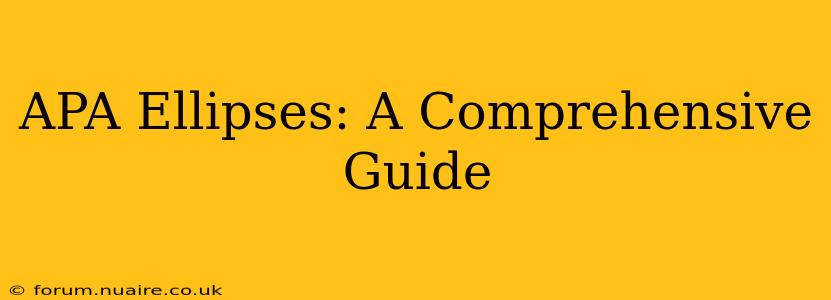The use of ellipses (...) in APA style can be a bit tricky. While seemingly simple – three evenly spaced dots indicating an omission in a quote – the nuances of their application require careful attention. This comprehensive guide will clarify the rules and exceptions, ensuring your APA citations are accurate and consistent.
What are Ellipses and When to Use Them in APA Style?
Ellipses represent omitted words or sentences within a direct quotation. They signify that material has been removed for brevity, clarity, or to maintain the original meaning's integrity. Crucially, they are not used to indicate trailing off or hesitation in spoken language. Their sole purpose in APA is to shorten a direct quote.
Using ellipses correctly is crucial for academic honesty. Omitting parts of a quote without indicating it could misrepresent the original author's intent. Proper use shows transparency and maintains the accuracy of your work.
How to Use Ellipses in APA Style
The APA style manual provides specific guidelines for using ellipses:
- Three evenly spaced dots: Always use three dots to indicate an omission within a sentence.
- Four dots: Use four dots if an omission occurs at the end of a sentence. The fourth dot represents the sentence's ending period. Note that the spacing should be consistent – three dots followed by a fourth period.
- Brackets around ellipses (optional): While not always required, adding brackets around the ellipses ([…]) can improve clarity, especially if the omission is significant or could lead to misinterpretation. This helps to visually distinguish the ellipsis from any periods already in the original text.
- Omitting the beginning of a quote: If you omit words from the beginning of a quote, you do not need to use ellipses. Start the quotation where you begin your excerpt.
- Omitting multiple sentences: Ellipses indicate omissions between sentences. If you omit several sentences, simply use three dots after the completed sentence before the omitted portion and three dots after the sentence before resuming the quotation.
Example:
Original quote: "The quick brown fox jumps over the lazy dog. The dog, quite sleepy, barely noticed."
Using ellipses:
- Omitting the middle of the first sentence: "The quick brown…dog."
- Omitting the first sentence entirely: "...The dog, quite sleepy, barely noticed."
- Omitting the first sentence and part of the second: "...quite sleepy, barely noticed."
- Omitting parts of both sentences with brackets: "The quick brown fox…[several sentences omitted]...barely noticed."
Common Mistakes to Avoid
Several common mistakes can undermine the accuracy and clarity of your citations:
- Uneven spacing: Ensure the three dots (or four) are evenly spaced. Inconsistent spacing can look unprofessional and distract the reader.
- Using ellipses to show a pause: This is incorrect within APA style; ellipses are only for omissions within a quote.
- Omitting essential information: Never omit crucial information that alters the meaning of the quote.
How Many Ellipses Should I Use?
This depends on the extent of the omission. If you remove only a few words, use three evenly spaced dots. For omitting an entire sentence or more, start with three dots, then place three more dots once you reach the quote you wish to continue. Remember if you are removing the final sentence and you want to indicate this, you'll use four dots.
Do I Need to Use Ellipses in Every Quote?
No. Ellipses are only necessary when you are omitting words, sentences, or paragraphs from a direct quote. If you use the complete quote, then ellipses are not needed.
Conclusion
Mastering the use of ellipses in APA style is essential for maintaining academic integrity and presenting your work professionally. By understanding and applying these guidelines, you can ensure your citations are accurate, clear, and correctly reflect the original source material. Remember, precision and accuracy are paramount in academic writing, and correctly utilizing ellipses contributes significantly to achieving this.

